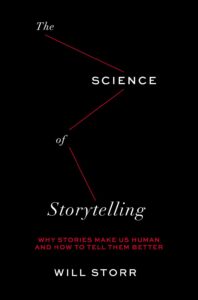Review: Two books that will boost your storytelling skills
by Michael Strickland

An increase in my pulse rate accompanies the uptick in my attention. I missed that the first time, in the fall of 2019. Now, less than a year later, I’m watching for the subtlest of changes.
I sit up a little bit straighter, pajama-clad legs pushing against the familiar couch cushions, as I brace for a change in my environment. Primal instincts stir, prompting me to pay attention.
It’s probably nothing. But, hey, you never know when something might eat you.
Stories That Stick
As I read Kindra Hall’s book for a second time, preparing to write this review, I appreciate her mastery of the basic business story a bit more. Taking a breath to relax, I slip back between the pages of Stories that Stick: How Storytelling Can Captivate Customers, Influence Audiences, and Transform Your Business.
A great narrative hijacks your attention, transporting you into the story, triggering visceral emotions like love or hate, and imprinting an impression that lasts beyond the final word. I was often reminded of that when reading Hall.
That’s unsurprising. She’s President and Chief Storytelling Officer at Steller Collective, a “hyper specialized storytelling agency.” So while her book offers a great road map to creating quick little tales that captivate, influence and transform, the real delight lies in her non-stop storytelling.
Hall’s introduction reads like the opening of a thriller. “Slovenia, JFK, and the Story That Kidnapped My Husband” left me intrigued and ready to read more. That was the point. What followed was the story of a shopping experience – involving cologne and a sales pitch with a foreign locale, a legendary character and a metaphorical kidnapping – told as if it were the start of a James Bond novel.
“At that moment,” Hall recalls, “Michael said three words I’ve never heard him say before: ‘I’ll take it.’”
In the first chapter, on business gaps and how story can help bridge them, we learn that the cutest boy in Hall’s high school was Andy K. and that Excel chewing gum brought the teens together. Grandma’s love of football kicks off a chapter on how great stories need four elements: identifiable characters, authentic emotion, a significant moment and specific details.
The bulk of the book focuses on the four types of stories, with intended audiences and purposes. Value and Customer stories support marketing and sales to prospects and customers. The Purpose Story helps leaders motivate and align teams, while a Founder Story increases stakeholder confidence.
Hall packs each section with stories that clearly demonstrate her points. Her customer stories also reinforce the strategic value of her work. Husband Michael, for example, returns as the identifiable character who uses a Purpose Story, with specific detail on how he once overcame adversity, to motivate workers.
Hall finishes with chapters on finding, crafting and telling. She presents a basic storytelling structure involving a Normal –> Explosion –> New Normal, and then shows how to add characters, emotions, moments and details to create a simple ten-second Steller Story.
The Science of Storytelling
I developed a deeper appreciation for Stories that Stick in between reads, because I read The Science of Storytelling: Why Stories Make Us Human and How to Tell them Better.
Will Storr covers much of the same basic ground as Hall, but with greater depth and completely different goals. She aims to help business storytellers share basic stories to sell cologne or inspire employees. Storr explains how storytellers can exploit the brain’s natural storytelling tendencies, transporting readers from couch to story.
Storr is an award-winning long-form journalist and novelist. He’s written for the Guardian and the New York Times, and has ghostwritten bestsellers for public figures. His own books include Selfie: How the West Became Self Obsessed and the novel The Hunger and Howling of Killian Lone.
He was researching his second book, The Unpersuadables: Adventures with the Enemies of Sciences, when he realized that storytelling was more than just something we do. Neuroscience confirms story is central to how we understand our world.
The brain focuses on changes in the environment, because these represent either an opportunity or a threat; a chance to eat, prosper and ultimately reproduce – or to be eaten. It then processes all it perceives by creating vivid models of a world it struggles to control.
“We experience our day-to-day lives in story mode. The brain creates a world for us to live in and populates it with allies and villains. It turns the chaos and bleakness of reality into a simple, hopeful tale, and at its centre it places its star – wonderful, precious me – who it sets on a series of goals that become the plots of our lives. Story is what brain does.”
Understanding how – how the brain naturally uses metaphor, deals with cause and effect, or favours filmic word order – allows storytellers to craft narratives that exploit the familiar.
Storr recommends shifting the focus of story from plot to what the brain naturally finds fascinating: character. Specifically, what he calls The Flawed Self. The most interesting characters are those forced to confront the fact that a key belief, a crucial part of their carefully constructed model of the world, is flawed.
And, along the way, forced to also confront that most central and dramatic of questions – Who am I?
Other crucial elements – plots, endings and meanings – flow from The Sacred Flaw. They usually follow the standard five-act structure, which Storr considers the “narrative equivalent of the three-and-a-half minute pop song” and they’re perfect for showing a character’s “theory of control being broken, changed and rebuilt.”
Storr presents few stories of his own. Instead, his book explains the neuroscience and psychology behind how we construct life and literature, with examples from the latter. But a 42-page appendix outlines the specific steps of his method.
I’m intrigued, and decide to create a quick little Steller Story with The Sacred Flaw Approach.
I begin with a writer who thought he’d read everything interesting on storytelling. He’s sitting on his couch, his legs pajama-clad, when suddenly his pulse quickens…
Michael Strickland is a Guelph-based strategic storyteller and story coach. You can see samples of his work on his website. He’ll deliver a 90-minute online webinar introducing the science behind and strategic uses of storytelling on the evening of October 13. Details, including exact start time and how to register, to come. Please save the date and look for more information from the CFG.




on April 5, 2021 at 3:05 pm
· Permalink
Loved this blog Michael, very well-written and informative. This post is a great read. Can`t wait to see more!
It is important for you, as an author of children’s literature, to pay close attention to how you write your story. It should be compelling, entertaining, and easily understandable.
Please read my blog about The Necessities of Children’s Book Storylines Hope this will help. Thank you.
Regards,
Patricia